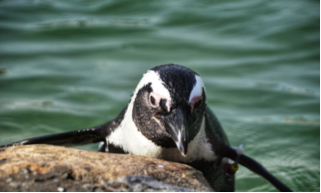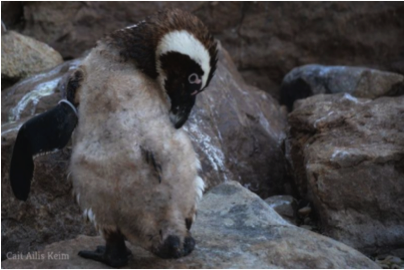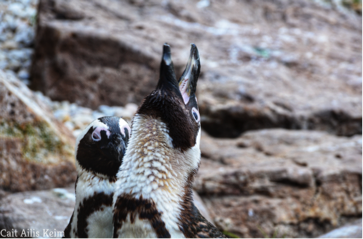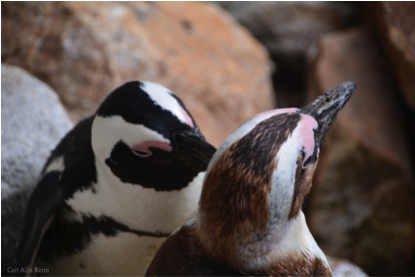

Lehigh Valley Zoo Animal Care Department
How Many Penguins Live at the Lehigh Valley Zoo?
There are 16 penguins that call the Lehigh Valley Zoo home, nine females and seven males, ranging in age from 2 years old to 22 years old.
 What Kind of Habitat do African Black-footed Penguins Have in the Wild?
What Kind of Habitat do African Black-footed Penguins Have in the Wild?
African Black-footed Penguins inhabit the rocky coast of Southern Africa. That is why our exhibit is comprised of a multitude of large and small rocks. This is what is natural for this species, and one of the most important parts of animal welfare is making sure the enclosure resembles the natural habitat of their wild counterparts. This gives allows them to display natural behaviors like rock-hopping, creating nests, and diving into the water.
Breakfast Time!
We have two penguin feeds per day at the zoo, one at 11 AM and one at 3 PM (in the spring/summer) or 2 PM (in the fall/winter). We feed out many different species of fish, often alternating species to provide as much variety as possible. The most common fish that are fed out are sardines, herring, capelin, smelt, mackerel, and trout. The penguins have the opportunity to eat as many fish as they want, as they know their bodies best. There are several reasons that an individual penguin may require more or less fish than they typically eat, including their yearly catastrophic molts. Each penguin might eat up to a pound of fish per day.
Penguin Fashion
While penguins do look quite dapper in their black and white “tuxedos”, this coloration is actually an incredible defense mechanism called countershading. This form of camouflage helps provide some protection against predators that penguins share the oceans with. If a predator swims above a penguin, they may miss them entirely because the penguin blends in nicely with the dark depths of the ocean. If a predator swims below the penguin, the penguin also might catch a lucky break because their white bellies blend in well with the lighter surface ocean and the sunlight reflecting through the water.
 As a year progresses, penguins will begin to look fairly drab. That is because their feathers become old and brittle as time goes on. Once every year, a penguin will go through their catastrophic molt, which means that they lose all of those old feathers all at once. The molt typically takes about two weeks from start to finish, and as soon as all the old feathers are shed, they grow in beautiful, shiny new feathers.
As a year progresses, penguins will begin to look fairly drab. That is because their feathers become old and brittle as time goes on. Once every year, a penguin will go through their catastrophic molt, which means that they lose all of those old feathers all at once. The molt typically takes about two weeks from start to finish, and as soon as all the old feathers are shed, they grow in beautiful, shiny new feathers.
Penguins also possess a spattering of spots across their bellies, that are as unique as a human fingerprint. This can help them identify each other and help researchers differentiate between penguins in the wild. All of our penguins have one additional fashionable item in their wardrobe: a multicolored bracelet. We put bracelets one each of our penguins to help us more easily identify who is who. The first color on the bracelet is either blue or pink beads. A bracelet with two blue beads means that the penguin is a male, and two pink beads means that the penguin is a female. The second color in the bracelet is simply two beads of a unique color to identify the individual.
 Noisy Neighbors
Noisy Neighbors
Our penguins can be heard across the zoo, as they use different calls to communicate with each other. Some calls are a penguin summoning their mate, some are penguins signaling to the rest of the colony to stay away from their nests, and others are simply affectionate noises.
Penguin Couples
Penguins are a monogamous species, meaning that, for the most part, they will spend their entire lives with the same partner. Many of our penguins are in relationships, such Don and Tee. Our pairs spend much of their days with each other, engaging in mutual-preening behaviors, swimming together, building nests, or simply taking naps.
 Penguin Parents
Penguin Parents
Penguins are largely considered exceptional parents within the animal kingdom. African Penguin parents take turns caring for any eggs that they lay, mother and father switching on and off the nest so that one can hunt for food while the other continues to incubate the eggs or protect their chicks. Penguins are very defensive of their nests, and that includes being defensive against zookeepers coming too close to a nesting location when in a zoo setting. We don’t mind, that means our penguins are doing exactly what they are supposed to: demonstrating natural behaviors.
African Penguins are part of something called an SSP, or a Species Survival Plan, which means that the genetics of all penguins is put into consideration before a penguin pair is recommended to breed. The goal of any SSP is to create stable, genetically diverse populations within zoos that may ultimately be released back into the wild in the future.
Two of our chicks still reside at the Lehigh Valley Zoo. Baridi and Bahati can be seen constantly interacting with guests toward the front of the exhibit.
Written by Caitlin Keim
Zookeeper & Enrichment Coordinator
Lehigh Valley Zoo | Schnecksville, PA